Eugenio Zampighi stands as a significant figure in late 19th and early 20th-century Italian art, celebrated for his intimate and affectionate portrayals of everyday life. An accomplished painter and photographer, Zampighi carved a niche for himself with genre scenes that captured the warmth and simplicity of Italian domesticity, particularly focusing on rural and peasant families. His work, deeply rooted in the traditions of Realism yet imbued with a gentle sentimentality, found immense favour not only in Italy but also with international audiences, particularly in Britain and the United States. This enduring appeal speaks to his skill in observation and his ability to craft narratives that resonated with a desire for idyllic, harmonious visions of life.
Early Life and Artistic Formation in Modena
Eugenio Zampighi was born in Modena, Italy, on October 17, 1859. Displaying artistic talent from a young age, he enrolled in the Modena Academy of Fine Arts at the remarkably early age of thirteen. This institution provided him with a solid foundation in academic drawing and painting techniques. During his formative years at the academy, he studied under respected local artists, most notably Antonio Simonazzi, a painter known for his adherence to Realism.
The academic environment in Modena fostered Zampighi's technical skills. He formed friendships with fellow students who would also pursue artistic careers, including Giovanni Muzzioli, who later became a prominent historical and genre painter himself, and Giovanni Belleti. These early connections and the rigorous training under figures like Simonazzi shaped Zampighi's initial artistic direction, grounding him in careful observation and precise rendering.
A pivotal moment in his early career arrived in 1880. At the age of just twenty-one, Zampighi won the prestigious Poletti Prize for painting. His winning entry, often cited as Un gladiatore retiario ferito nell'Anfiteatro Flavio (A Retiarius Gladiator Wounded in the Flavian Amphitheatre), demonstrated his mastery of historical subjects and academic composition, showcasing the skills honed at the Modena Academy. This award was not merely an honour; it came with a crucial scholarship.
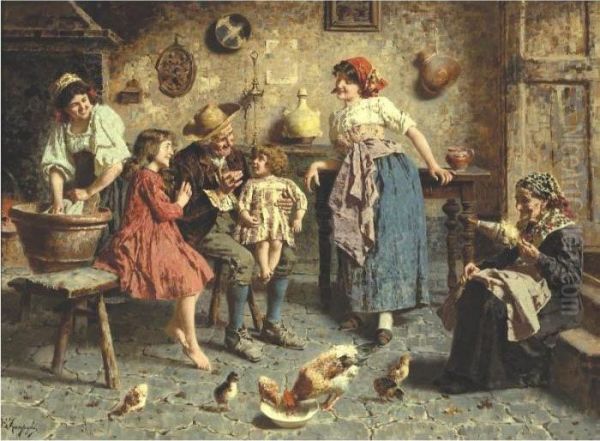
The Poletti Prize provided Zampighi with the financial means to broaden his artistic horizons beyond Modena. The scholarship enabled him to travel and study in the major artistic centres of Italy, specifically Rome and Florence. This opportunity was instrumental in exposing him to a wider range of artistic influences and contemporary movements, setting the stage for the next phase of his development.
Broadening Horizons: Rome and Florence
Armed with the Poletti scholarship, Zampighi embarked on a period of study and travel. His time in Rome exposed him to the grandeur of classical antiquity and the works of Renaissance and Baroque masters, enriching his understanding of composition and human anatomy. Rome, as the historical heart of Italy, offered a wealth of inspiration, though Zampighi's artistic temperament would ultimately gravitate away from monumental historical scenes towards more intimate subjects.
Following his time in Rome, Zampighi moved to Florence, a city that would become his primary base for many years. He settled there around 1884. Florence, during the latter half of the 19th century, was a vibrant artistic hub, particularly known as the birthplace of the Macchiaioli movement. This move proved decisive for Zampighi's artistic direction, immersing him in an environment where new ideas about Realism and the depiction of contemporary life were actively being debated and practiced.
Florence offered a stimulating atmosphere. It was a city attracting artists from across Italy and beyond, fostering exchanges and influencing stylistic developments. While Zampighi maintained his grounding in academic technique, the Florentine environment encouraged a greater focus on everyday subjects and the effects of light and colour, elements that would become central to his mature style. His decision to settle in Florence marked the true beginning of his professional career as an independent artist.
The Florentine Years and the Macchiaioli Influence
During his time in Florence, Zampighi inevitably came into contact with the ideas and, likely, the artists associated with the Macchiaioli. This group, active primarily between the 1850s and 1870s but whose influence persisted, reacted against the constraints of academic painting. They advocated for painting outdoors (plein air) and using patches or spots (macchie) of colour to capture the immediate effects of light and shadow, often focusing on scenes of contemporary Italian life, landscapes, and historical events related to the Risorgimento.
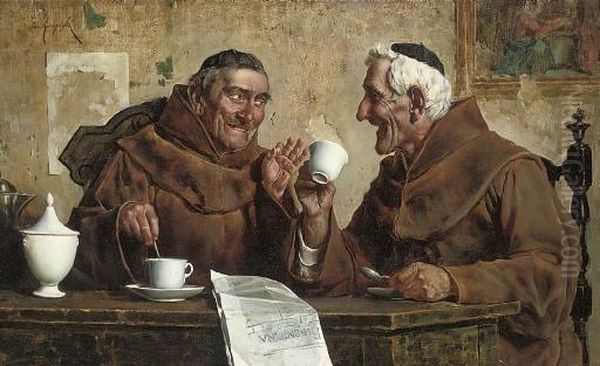
Key figures of the Macchiaioli included Giovanni Fattori, Silvestro Lega, and Telemaco Signorini. Fattori was renowned for his military scenes and Tuscan landscapes, Lega for his quiet domestic interiors and garden scenes, and Signorini for his cityscapes and social observations. While Zampighi did not become a core member of the group (which had largely dispersed by the time he settled in Florence), their emphasis on realism, contemporary subjects, and the truthful depiction of light resonated with his own inclinations.
However, Zampighi adapted these influences to his own distinct style. Unlike the often bold, summary brushwork of the core Macchiaioli, Zampighi retained a more detailed, polished finish, perhaps reflecting his academic training and potentially influenced by the highly finished surfaces popularised by French academic painters like Jean-Léon Gérôme. Furthermore, while the Macchiaioli often depicted outdoor scenes or the brighter aspects of middle-class life, Zampighi increasingly focused on interior settings, particularly those of the rural peasantry.
Another significant influence during this period was the work of Gaetano Chierici. Chierici, slightly older than Zampighi and also active in the realm of genre painting, specialized in highly detailed, often humorous or anecdotal scenes of peasant family life, frequently set within rustic kitchens. Zampighi's choice of subject matter and his meticulous attention to the details of domestic interiors – the textures of plaster walls, earthenware pots, simple furniture, and traditional clothing – show a clear affinity with Chierici's popular works. Zampighi, however, often imbued his scenes with a greater degree of warmth and sentimentality compared to Chierici's sometimes more objective or caricatural approach.
Subject Matter: The Italian Domestic Sphere
Eugenio Zampighi's artistic identity is inextricably linked to his chosen subject matter: the everyday lives of ordinary Italian people, predominantly peasants and rural families. He turned his gaze towards the intimate moments within the home – the kitchen, the hearth, the family gathered around a table. His canvases are populated with grandparents telling stories, mothers tending to infants, children playing, families sharing meals, and neighbours engaging in simple social rituals.
These scenes are characterized by an atmosphere of warmth, affection, and harmony. Zampighi excelled at capturing tender interactions: a grandfather bouncing a grandchild on his knee, a young couple sharing a quiet glance, a mother patiently feeding her child. He often included multiple generations within a single composition, emphasizing themes of family continuity, respect for elders, and the simple joys of domestic life. Works like A Happy Family or Three Generations exemplify this focus.
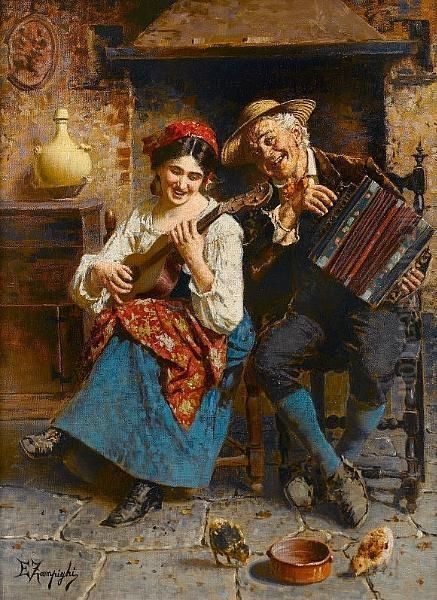
His depiction of rural life was largely idyllic. Unlike the Social Realism movement burgeoning elsewhere in Europe, exemplified by artists like Gustave Courbet or Jean-François Millet in France who often highlighted the hardships and toil of peasant labour, Zampighi generally avoided overt social commentary or depictions of poverty and struggle. His peasants appear content, well-fed, and comfortably situated within charmingly rustic, if simple, interiors. This idealized vision contributed significantly to his popularity, offering viewers a comforting and picturesque image of Italian life.
This focus on the positive and harmonious aspects of peasant life aligned with a broader market demand for genre scenes that were pleasing and emotionally resonant. While some Italian artists, like Teofilo Patini, were tackling the harsh realities of rural poverty and emigration in regions like the Abruzzo (part of the Verismo movement in art), Zampighi catered to a different sensibility, one that sought reassurance and charm in the depiction of the everyday. His Italy was one of enduring traditions, strong family bonds, and simple pleasures.
Artistic Style and Technique
Zampighi developed a distinctive style that blended meticulous realism with a palpable layer of sentimentality. His academic training is evident in his confident drawing, solid rendering of figures, and careful attention to anatomical accuracy. He possessed a keen eye for detail, meticulously rendering the textures of fabrics, the surfaces of objects, the play of light on different materials, and the specific characteristics of domestic interiors. Costumes, often traditional peasant attire, were depicted with ethnographic care.
His use of light was particularly effective in creating mood. Zampighi favoured warm interior lighting, often emanating from a hearth, a window, or a lantern. This light typically illuminates the central figures and interactions, casting gentle shadows in the surrounding space and enhancing the sense of intimacy and enclosure. His colour palette tended towards warm earth tones – browns, ochres, reds – further contributing to the cozy and inviting atmosphere of his scenes.
Compositionally, Zampighi often arranged his figures in relatively shallow spaces, bringing the viewer close to the action. Groups are typically clustered together, emphasizing their interaction and emotional connection. He frequently employed anecdotal details – a playful kitten, a spilled glass of wine, a shared joke – to add narrative interest and charm to his compositions. This approach shares similarities with 17th-century Dutch Golden Age genre painters like Jan Steen or Johannes Vermeer, who also excelled at depicting intimate domestic scenes, though Zampighi's style is distinctly of the late 19th century.
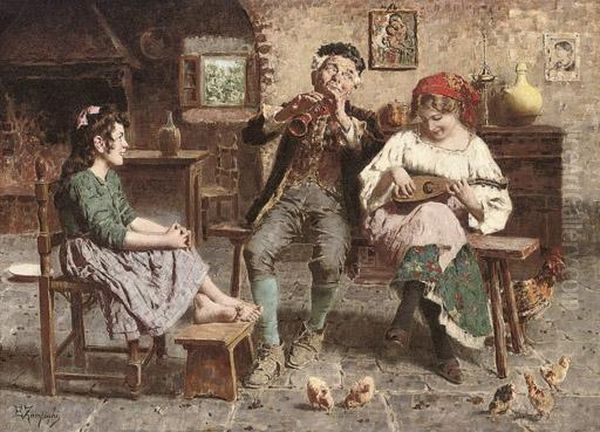
While highly skilled, Zampighi's working methods sometimes led to criticism, particularly later in his career. He was known to reuse successful compositions, figures, and studio props across multiple paintings, sometimes with only minor variations. He maintained a studio in Florence equipped with rustic furniture and props, and employed local models whom he dressed in traditional costumes. While this practice ensured consistency and efficiency, allowing him to meet market demand, it also resulted in a degree of predictability and repetition in his oeuvre, leading some critics to view his work as formulaic. Comparisons might also be drawn to other successful European genre painters of the era, such as Franz von Defregger in Austria/Germany or Eastman Johnson in the United States, who also specialized in rural and domestic themes.
Zampighi the Photographer
Beyond his work as a painter, Eugenio Zampighi was also an active photographer. This dual practice was not uncommon among artists in the late 19th century, as photography became an increasingly accessible tool. For Zampighi, photography seems to have served multiple purposes, acting both as a potential source of studies for his paintings and as an independent artistic medium.
His photographic subjects closely mirrored those of his paintings: staged scenes of Italian peasant life, domestic interiors, family groups, and portraits of individuals in traditional costume. He often used the same models and props that appeared in his canvases, creating photographic counterparts to his painted narratives. These photographs share the same emphasis on warmth, anecdote, and idealized rural charm found in his paintings.
The relationship between his photography and painting is complex. It is likely that he used photographs as aides-mémoire or compositional studies, allowing him to capture specific poses, expressions, or arrangements of figures and objects that he could later translate into paint. This practice would have facilitated the detailed realism and the repetition of motifs seen in his work. However, his photographs also stand as works in their own right, demonstrating a careful eye for composition and lighting within the photographic medium itself.
A significant collection of Zampighi's photographic work came to light relatively recently. In 2007, the Fotomuseo Giuseppe Panini in his native Modena held an exhibition titled "Painter and Photographer: Eugenio Zampighi," showcasing over 150 photographs selected from a larger archive acquired by the museum. This exhibition shed new light on this aspect of his career, revealing the extent of his photographic activity and its intimate connection to his better-known paintings. It confirmed his consistent artistic vision across both media, focused on celebrating the perceived virtues of traditional Italian life.
Key Works Explored
Several paintings stand out as representative of Eugenio Zampighi's oeuvre, encapsulating his typical themes and stylistic approach.
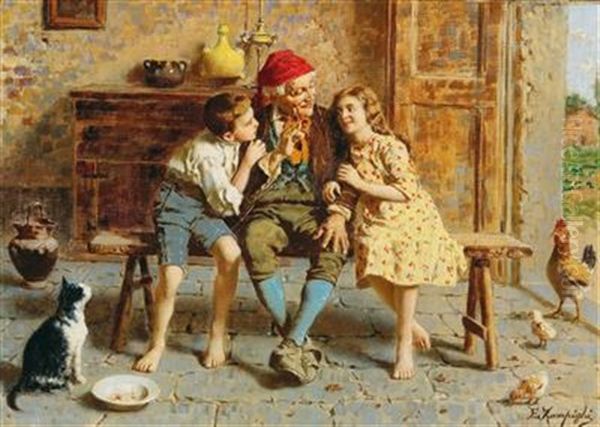
A Happy Family (Una Famiglia Felice): This title, often applied to several variations of similar scenes, typically depicts a multi-generational family group gathered in a rustic interior, perhaps around a meal or near the hearth. Grandparents, parents, and children interact affectionately, embodying the ideal of domestic harmony and familial bonds that Zampighi frequently celebrated. The warm lighting and detailed rendering of the setting are characteristic.
The New Friend (Il Nuovo Amico): Often depicting a mother or grandmother introducing a baby or small child to a pet, like a puppy or kitten, this theme highlights innocence, tenderness, and the simple joys of childhood within the domestic sphere. The focus is on the gentle interaction and the emotional connection between the figures.
Latest News (Ultime Notizie): This subject usually involves figures gathered around someone reading a letter or newspaper, sharing news within the family or community. It provides an opportunity for Zampighi to depict varied expressions of interest, curiosity, or perhaps concern, adding a narrative element to the domestic scene.
Three Generations (Tre Generazioni): Similar to A Happy Family, this theme explicitly focuses on the continuity of family lineage. A typical composition might show a grandparent, a parent (often a mother), and a child together, engaged in a shared activity or quiet moment, symbolizing the passage of time and the strength of family ties. A version auctioned in 2023 depicted such a group seated together, measuring 57x77 cm.
La Visita del Nonno (The Grandfather's Visit): This popular theme shows a grandfather figure, often depicted as jovial and affectionate, interacting playfully with his grandchildren. It underscores the respected role of elders within the family structure and the loving bonds between generations. One version, measuring 56x78 cm, was estimated at €10,000-€20,000 at auction.
Music Hath Charms (Il Fascino della Musica): Zampighi often depicted scenes involving simple musical performances within the home, such as someone playing a pipe, accordion, or guitar, with family members listening attentively. These works celebrate folk traditions and the role of music in bringing families together.
These examples illustrate Zampighi's consistent focus on positive, heartwarming narratives set within meticulously rendered rustic interiors. His skill lay in making these everyday moments feel both authentic and emotionally engaging, contributing to their widespread appeal.
International Success and the Art Market

Eugenio Zampighi achieved considerable commercial success during his lifetime, particularly beyond the borders of Italy. His charming and accessible depictions of Italian life found a ready market among middle-class collectors and tourists, especially in Great Britain and the United States. These audiences were often drawn to the picturesque and romanticized vision of Italy presented in his works.
His paintings offered an appealing contrast to the industrialization and social complexities of modern life in Britain and America. They represented a seemingly simpler, more harmonious world rooted in tradition, family, and nature. The detailed realism combined with overt sentimentality made his work easy to understand and appreciate, requiring little interpretation beyond the immediate narrative.
Art dealers likely played a significant role in promoting Zampighi's work internationally, facilitating sales to foreign collectors. His paintings frequently appeared in exhibitions and galleries catering to the popular taste for genre scenes. The relatively consistent style and subject matter also made his work recognizable and marketable. Reproductions, possibly through prints or photographs of his paintings, likely further broadened his reach and popularity.
The prices achieved for his works at auction, both during his lifetime and posthumously, attest to his market success. Even today, his paintings continue to command respectable sums, with works regularly appearing at major auction houses like Christie's and Sotheby's, as well as regional European auctioneers. For example, A Happy Family sold for €25,000 in 2023, and Three Generations fetched DKK 100,000 (around €13,400) in the same year. This enduring market presence reflects the continued appeal of his idyllic vision, even if critical perspectives have evolved.
Critical Reception and Evolving Legacy
During his peak years, Eugenio Zampighi enjoyed considerable popularity and positive reception, particularly from the public and the commercial art market. His technical skill was undeniable, and the emotional appeal of his subjects resonated widely. He was seen as a master chronicler of Italian folk life, capturing charming vignettes with warmth and precision.
However, from a critical art historical perspective, his reputation has been more complex and subject to revision. While acknowledged for his technical proficiency and popularity, Zampighi has often been criticized for the very qualities that made him successful. His tendency towards sentimentality has been viewed by some critics as bordering on saccharine, lacking the emotional depth or psychological complexity found in the work of other realists.
The idealized and repetitive nature of his depictions of peasant life has also drawn criticism. By consistently presenting a harmonious and picturesque view, critics argue, he ignored the often harsh realities of rural poverty, social inequality, and emigration that were significant issues in late 19th and early 20th-century Italy. His work, therefore, can be seen as contributing to a romanticized, sometimes stereotypical, image of Italian peasantry, particularly for foreign audiences. His repetitive use of compositions and motifs further led to accusations of commercialism and a lack of artistic innovation.
Compared to the Macchiaioli like Fattori or Lega, who engaged more directly with the social and political changes of their time or explored more innovative formal means, Zampighi's work appears more conservative and less challenging. He occupies a space closer to the academic genre tradition, albeit focused on contemporary rural subjects rather than historical or mythological ones. Figures like Adriano Cecioni, a sculptor and critic associated with the Macchiaioli, championed a realism that often had a sharper social edge than Zampighi's gentle portrayals. Even compared to other artists depicting rural life, like Giovanni Segantini whose Symbolist-influenced works explored the relationship between humanity and nature with greater spiritual depth, Zampighi's focus remained firmly on the anecdotal and the domestic.
Despite these critical reservations, Zampighi's legacy endures. He remains a significant representative of Italian genre painting in the late 19th and early 20th centuries. His works are held in museum collections, including the Museum of Modern Art in Modena and the Civico d'Arte Museum at the University of Padua. His paintings continue to be sought after by collectors who appreciate his technical skill and the nostalgic charm of his subjects. He successfully captured a specific, albeit idealized, vision of Italian life that held immense appeal in its time and continues to evoke a sense of warmth and simple humanity.
Later Life and Conclusion
Details about Eugenio Zampighi's later life are less documented than his active years in Florence. It is suggested that he may have returned to the Modena area, possibly residing in Maranello, particularly during the turbulent years leading up to and including World War II. Some sources indicate that he may have engaged in teaching during his later years, passing on the academic principles he had mastered.
Eugenio Zampighi passed away in 1944, reportedly in Maranello, near his birthplace of Modena. He left behind a substantial body of work, both paintings and photographs, that consistently explored the themes of family, tradition, and the simple rhythms of Italian domestic life.
In conclusion, Eugenio Zampighi was a highly skilled and commercially successful artist whose work occupies a distinct place in Italian art history. While perhaps not an innovator in the vein of the Macchiaioli or the later avant-gardes, he excelled within the genre tradition, creating meticulously crafted and emotionally resonant scenes of everyday life. His paintings, characterized by warm interiors, affectionate family interactions, and an idealized vision of rural Italy, captured the imagination of a wide audience in his time. Though subject to criticism for sentimentality and repetition, his work remains a valuable record of popular tastes and cultural ideals of the era, and his ability to convey intimacy and harmony continues to find appreciation. He remains a beloved chronicler of the Italian hearth and home.